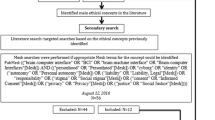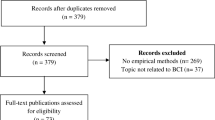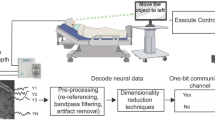Abstract
Brain-computer interfaces mediate interaction and communication via technology without relying on visible behavior. Thereby, they promise to benefit patients with neurological diseases that destroy motor functions. In particular, brain-computer interfaces may promote insight into mental states and cognitive functions in severe acquired brain damage, for example in disorders of consciousness (DOC), like the unresponsive wakefulness syndrome (UWS) and the minimally conscious state (MCS). The clinical research and development for brain-computer interfaces reveals multiple challenges, which are examined by methods of social science research. Strategies to cope with and to resolve obstacles are derived from contributions by caregivers, academic experts, and researchers. Challenges and strategies are identified and analyzed regarding the lack of validity in case of false results, the choice of communication topics, informed consent, well-being and avoidance of harm, transparency regarding restricted research resources, prevention of false hopes and beliefs, and data protection. Negative results concerning communication skills in the patient population with severe acquired brain damage are not valid for prognosis because of individual variants and the novel condition of the technology. Reasonable communication begins with exchanges about topics of everyday life and care. Informed consent, depending on legally authorized representatives, is legitimate in view of the potential benefit for the individual patient. Attention to the patients’ levels of comfort during human-technology interaction fosters their quality of life. Regarding the research and development process, limited resources are to be made transparent, exaggerated expectations should be prevented, and data protection rules need to be followed.
Access this chapter
Tax calculation will be finalised at checkout
Purchases are for personal use only
Similar content being viewed by others
References
Giacino, J.T., Fins, J.J., Laureys, S., Schiff, N.D.: Disorders of consciousness after acquired brain injury: the state of the science. Nat. Rev. Neurol. 10(2), 99–114 (2014). https://doi.org/10.1038/nrneurol.2013.279. Accessed 24 Feb 2020
Steppacher, I., Kaps, M., Kissler, J.: Against the odds: a case study of recovery from coma after devastating prognosis. Ann. Clin. Transl. Neurol. 3(1): 61–65 (2015). https://doi.org/10.1002/acn3.269. Accessed 24 Feb 2020
Giacino, J.T., et al.: Comprehensive systematic review update summary: disorders of consciousness: report of the guideline development, dissemination, and implementation subcommittee of the American Academy of Neurology; the American Congress of Rehabilitation Medicine; and the National Institute on Disability, Independent Living, and Rehabilitation Research. Arch. Phys. Med. Rehabil. 99(9), 1710–1719 (2018). https://doi.org/10.1016/j.apmr.2018.07.002. Accessed 24 Feb 2020
Chatelle, C., Chennu, S., Noirhomme, Q., Cruse, D., Owen, A.M., Laureys, S.: Brain-computer interfacing in disorders of consciousness. Brain Inj. 26(12), 1510–1522 (2012). https://doi.org/10.3109/02699052.2012.698362. Accessed 24 Feb 2020
Monti, M.M., et al.: Willful modulation of brain activity in disorders of consciousness. N. Engl. J. Med. 362, 579–589 (2010). https://doi.org/10.1056/nejmoa0905370. Accessed 24 Feb 2020
Finke, A., Steppacher, I., Kissler, J., Ritter, H.: Frequency band variations predict EEG single-trial classification performance in disorder of consciousness patients. In: Conference Proceedings – IEEE Engineering in Medicine and Biology Society 2018, pp. 1927–1930 (2018). https://doi.org/10.1109/embc.2018.8512719. Accessed 24 Feb 2020
Brukamp, K.: Responsible research and innovation for communication by brain-computer interfaces in severe brain damage. In: Boll, S., Hein, A., Heuten, W., Wolf-Ostermann, K. (eds.): Zukunft der Pflege – Innovative Technologien für die Praxis. Tagungsband der 1. Clusterkonferenz 2018, pp. 116–119. Future of Nursing – Innovative Technologies for Practice. Conference Proceedings of the First Joint Conference 2018, pp. 116–119. [German and English] Universität Oldenburg, Oldenburg (2018). https://www.pflegeinnovationszentrum.de/wp-content/uploads/2018/12/22.-Responsible-Research-und-Innovation-for-Communication-by-Brain-Computer-Interfaces-in-Severe-Brain-Damage.pdf. Accessed 24 Feb 2020
Manzeschke, A., Weber, K., Rother, E., Fangerau, H.: Ergebnisse der Studie „Ethische Fragen Im Bereich Altersgerechter Assistenzsysteme“. Results of the study “ethical questions in the area age-appropriate assistive systems”. [German] VDI/VDE Innovation + Technik Gmbh, Berlin (2013). https://www.technik-zum-menschen-bringen.de/dateien/service/broschuere-ethische-fragen-altersgerechte-assistenzsysteme.pdf/download. Accessed 24 Feb 2020
Mayring, P.: Qualitative content analysis: theoretical foundation, basic procedures and software solution. Klagenfurt, Austria (2014). nbn-resolving.de/urn:nbn:de:0168-ssoar-395173. Accessed 24 Feb 2020
Tirschmann, F., Brukamp, K.: Forschung an Neurotechnologien für erworbene Hirnschädigungen: Empirische Belege für die sozialen und ethischen Implikationen in der Pflegesituation. Research on neurotechnologies for acquired brain damage: empirical evidence for social and ethical implications in the nursing situation. [German] Pflege & Gesellschaft: Zeitschrift für Pflegewissenschaft Nurs. Soc. J. Nurs. Sci. [German] 24(3), 218–236 (2019)
World Medical Association: WMA Declaration of Helsinki – Ethical Principles for Medical Research Involving Human Subjects. Fortaleza, Brazil (2013). https://www.wma.net/policies-post/wma-declaration-of-helsinki-ethical-principles-for-medical-research-involving-human-subjects. Accessed 24 Feb 2020
Brukamp, K.: Motorunabhängige Kommunikation durch körperlich hochgradig eingeschränkte Patienten. Neurowissenschaftliche Grundlagen und Patientenautonomie. Motor-independent communication by physically severely challenged patients: neuroscientific research results and patient autonomy. Der Nervenarzt Physician Neural Disord. [German] 84(10), 1190–1195 (2013). https://doi.org/10.1007/s00115-013-3813-9. Accessed 24 Feb 2020
Steppacher, I., Kissler, J.: A problem shared is a problem halved? comparing burdens arising for family caregivers of patients with disorders of consciousness in institutionalized versus at home care. BMC Psychol. 6(1), 58 (2018). https://doi.org/10.1186/s40359-018-0272-x. Accessed 24 Feb 2020
King, G., Nalder, E., Stacey, L., Hartman, L.R.: Investigating the adaptation of caregivers of people with traumatic brain injury: a journey told in evolving research traditions. Disabil. Rehabil. 2330–2367 (2020). https://doi.org/10.1080/09638288.2020.1725158. Accessed 24 Feb 2020
De Goumoëns, V., Rio, L.M., Jaques, C., Ramelet, A.S.: Family-oriented interventions for adults with acquired brain injury and their families: a scoping review. JBI Database System. Rev. Implement. Rep. 16(12), 2330–2367 (2018). https://doi.org/10.11124/jbisrir-2017-003846. Accessed 24 Feb 2020
General Data Protection Regulation: Regulation (EU) 2016/679 of the European Parliament and of the Council of 27 April 2016 on the Protection of Natural Persons with Regard to the Processing of Personal Data and on the Free Movement of Such Data, and Repealing Directive 95/46/EC (General Data Protection Regulation) (2016). https://eur-lex.europa.eu/legal-content/EN/TXT/?uri=uriserv%3AOJ.L_.2016.119.01.0001.01.ENG&toc=OJ%3AL%3A2016%3A119%3ATOC. Accessed 24 Feb 2020
Author information
Authors and Affiliations
Corresponding author
Editor information
Editors and Affiliations
Rights and permissions
Copyright information
© 2020 Springer Nature Switzerland AG
About this paper
Cite this paper
Brukamp, K. (2020). Brain-Computer Interfaces for Communication in Severe Acquired Brain Damage: Challenges and Strategies in Clinical Research and Development. In: Antona, M., Stephanidis, C. (eds) Universal Access in Human-Computer Interaction. Design Approaches and Supporting Technologies. HCII 2020. Lecture Notes in Computer Science(), vol 12188. Springer, Cham. https://doi.org/10.1007/978-3-030-49282-3_8
Download citation
DOI: https://doi.org/10.1007/978-3-030-49282-3_8
Published:
Publisher Name: Springer, Cham
Print ISBN: 978-3-030-49281-6
Online ISBN: 978-3-030-49282-3
eBook Packages: Computer ScienceComputer Science (R0)




